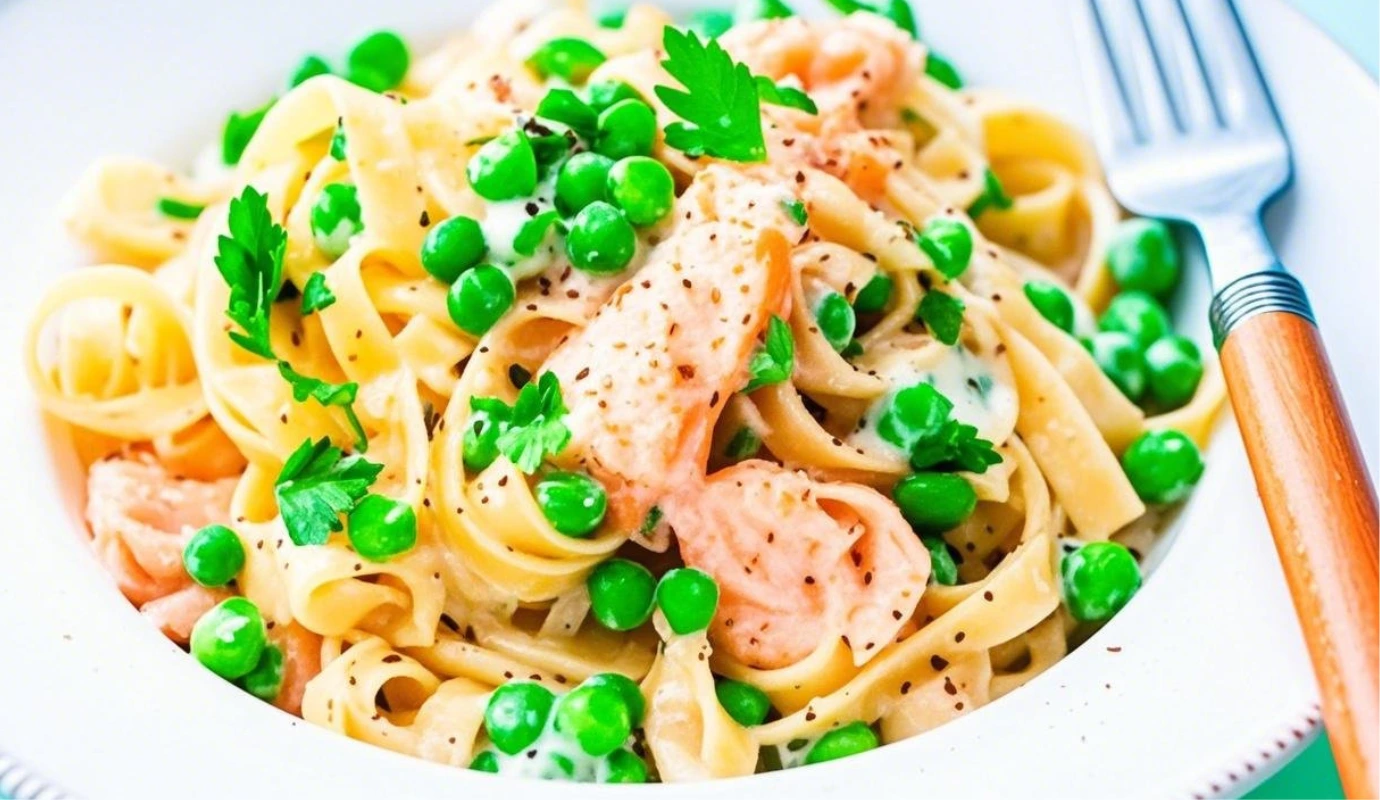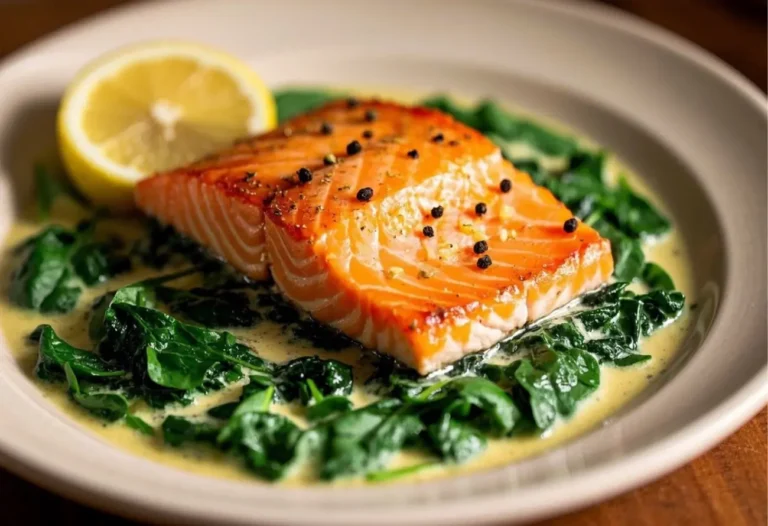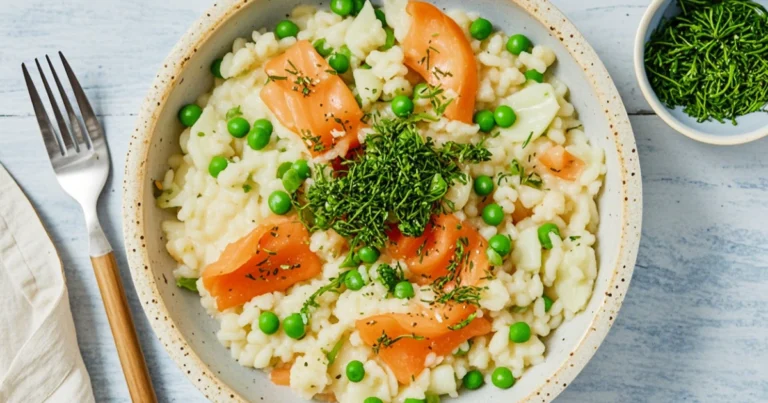Creamy Pasta with Salmon And Peas: A 30-Minute Weeknight Winner
Table of Contents
When Comfort Meets Elegance
Remember that feeling when you walk through the door after a long day, completely drained, only to realize you still need to make dinner? We’ve all been there. It was during one of these moments that I discovered the magic of creamy pasta with salmon and peas – a dish that transformed my weeknight cooking forever.
Picture this: silky strands of pasta coated in a velvety sauce, tender morsels of pink salmon, and sweet emerald peas creating a harmony of flavors that feels both indulgent and nourishing. This isn’t just another pasta recipe; it’s the perfect balance of sophistication and simplicity, bringing restaurant-quality flavor to your table in just 30 minutes.
What makes this dish truly special is how it elevates everyday ingredients into something extraordinary. The rich cream sauce carries hints of bright lemon and aromatic herbs, while the salmon adds a luxurious quality that belies the dish’s quick preparation time. Each forkful delivers that perfect bite – a little pasta, a piece of salmon, and the surprising pop of sweetness from the peas.
Whether you’re cooking for your family on a Tuesday night or entertaining friends on the weekend, this creamy pasta with salmon and peas strikes that elusive balance between impressive and achievable. It’s the kind of recipe that makes you look like you’ve spent hours in the kitchen, when in reality, you’ve barely broken a sweat.
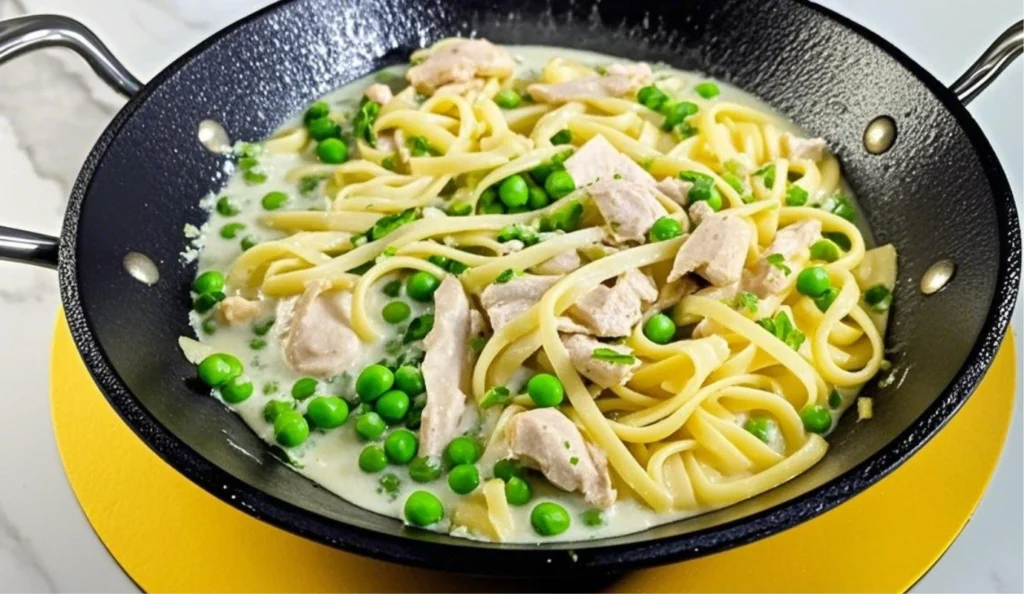
Why This Pasta with Salmon and Peas Will Become Your New Favorite
Before diving into the details, let’s talk about why this dish deserves a permanent spot in your recipe collection. In a world of complicated cooking techniques and hard-to-find ingredients, this pasta with salmon and peas stands out for its remarkable combination of simplicity and satisfaction.
- Ready in just 30 minutes – from pantry to plate faster than delivery could arrive
- Uses straightforward ingredients you likely already have or can easily find
- Provides balanced nutrition with protein from salmon, carbs from pasta, and vegetables from peas
- Offers versatility with easy substitutions based on what you have available
- Creates minimal cleanup with just one pot and one pan required
- Impresses dinner guests while requiring minimal cooking expertise
- Delivers restaurant-quality flavors without the restaurant prices
The beauty of this recipe lies in its ability to transform ordinary moments into something special. On those evenings when cooking feels like a chore, this pasta with salmon and peas reminds you that delicious food doesn’t have to be complicated or time-consuming. It’s the culinary equivalent of finding that perfect outfit that makes you look put-together with almost no effort.
The Perfect Pasta with Salmon and Peas: Essential Ingredients
What You’ll Need in Pasta with Salmon And Peas
The magic of this dish begins with gathering the right ingredients. While the list might seem substantial at first glance, most items are kitchen staples that combine to create something truly remarkable. Quality matters here, so opt for the freshest salmon you can find and real Parmesan cheese rather than pre-grated varieties when possible.
| Ingredient | Quantity | Notes |
|---|---|---|
| Pasta (fettuccine, linguine, or penne) | 12 oz (340g) | Choose your favorite shape |
| Fresh salmon filet | 1 lb (450g) | Skin removed, cut into 1-inch pieces |
| Frozen or fresh peas | 1 cup (150g) | Thawed if frozen |
| Heavy cream | 1 cup (240ml) | For the silkiest sauce |
| Garlic | 3 cloves, minced | Adjust to taste |
| Shallot or onion | 1 medium, finely chopped | Adds depth of flavor |
| Lemon | 1 whole | Zest and juice needed |
| Parmesan cheese | 1/2 cup (50g), grated | Plus extra for serving |
| Fresh dill | 2 tablespoons, chopped | Or substitute with parsley |
| Olive oil | 2 tablespoons | For sautéing |
| Salt and pepper | To taste | Sea salt works best |
| Red pepper flakes | 1/4 teaspoon (optional) | Adds a gentle heat |
Each ingredient plays a crucial role in building the flavors of this dish. The salmon provides rich, tender bites and heart-healthy omega-3 fatty acids. The peas offer sweet pops of color and nutrition. The cream creates a luxurious base that coats every strand of pasta. The lemon brightens the entire dish with its zesty punch. Together, they create a symphony of flavors that’s greater than the sum of its parts.
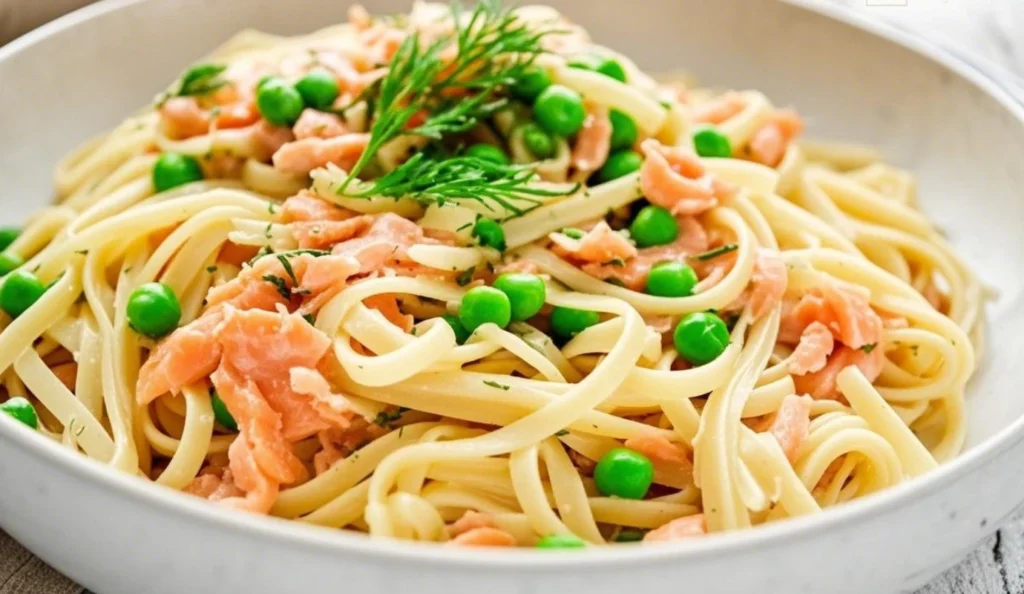
Equipment List
Part of what makes this recipe so approachable is its minimal equipment requirements. You won’t need any specialized tools or appliances – just the basics found in most kitchens.
- Large pot for pasta
- Large skillet or sauté pan (12-inch works perfectly)
- Cutting board and sharp knife
- Measuring cups and spoons
- Zester or fine grater for the lemon
- Colander for draining pasta
Having everything ready before you begin cooking will make the process flow smoothly. The professional kitchen principle of “mise en place” (everything in its place) applies perfectly here – once you start cooking, the dish comes together quickly, so having your ingredients prepped and equipment ready ensures success.
Step-by-Step Instructions for Perfect Pasta with Salmon and Peas
Preparation (10 minutes)
The key to making this dish feel effortless lies in proper preparation. Taking a few minutes to organize your ingredients before turning on the heat will make the cooking process smooth and enjoyable.
- Fill a large pot with water, add a generous tablespoon of salt, and bring to a boil for the pasta
- While waiting for the water to boil, remove skin from salmon and cut into 1-inch cubes
- Finely chop shallot and mince garlic
- Zest the lemon, then cut in half and juice one half (you’ll need about 1 tablespoon of juice)
- Grate the Parmesan cheese if using a block
- Chop the fresh herbs and measure out remaining ingredients
- If using frozen peas, place them in a colander and rinse with cool water to begin thawing
Having everything prepped and within arm’s reach transforms cooking from stressful to satisfying. This front-loaded effort pays dividends when it’s time to bring the dish together.
Cooking Method (20 minutes)
Now comes the part where everything harmonizes into a delicious meal. The process moves relatively quickly, so staying engaged and focused will help you achieve perfect results.
- Cook pasta according to package directions until al dente (typically 8-10 minutes)
- While pasta cooks, heat olive oil in a large skillet over medium heat
- Add chopped shallots to the hot oil and sauté until translucent and fragrant (2-3 minutes)
- Add minced garlic and cook just until fragrant, being careful not to brown it (30 seconds)
- Add salmon pieces to the pan, season with a pinch of salt and pepper, and cook until just beginning to turn opaque on the outside but still slightly rare in the center (2-3 minutes)
- Reduce heat to medium-low and pour in heavy cream, stirring gently to create a sauce
- Add peas and bring mixture to a gentle simmer, allowing sauce to thicken slightly (2-3 minutes)
- Stir in lemon zest, lemon juice, and half the Parmesan cheese until melted and incorporated
- Season with additional salt, freshly ground black pepper, and red pepper flakes if desired
- Just before pasta finishes cooking, reserve 1/2 cup of the starchy pasta water, then drain pasta
- Add drained pasta directly to the sauce, tossing gently to coat (add pasta water a tablespoon at a time if sauce seems too thick)
- Fold in fresh herbs and remaining Parmesan, then remove from heat and let stand for 1-2 minutes to allow sauce to be absorbed
The beauty of this cooking process lies in its timing – the pasta finishes cooking just as the sauce comes together, allowing for that perfect marriage of flavors. The reserved pasta water contains starches that help the sauce cling to the pasta, creating a silky texture that restaurant chefs rely on.
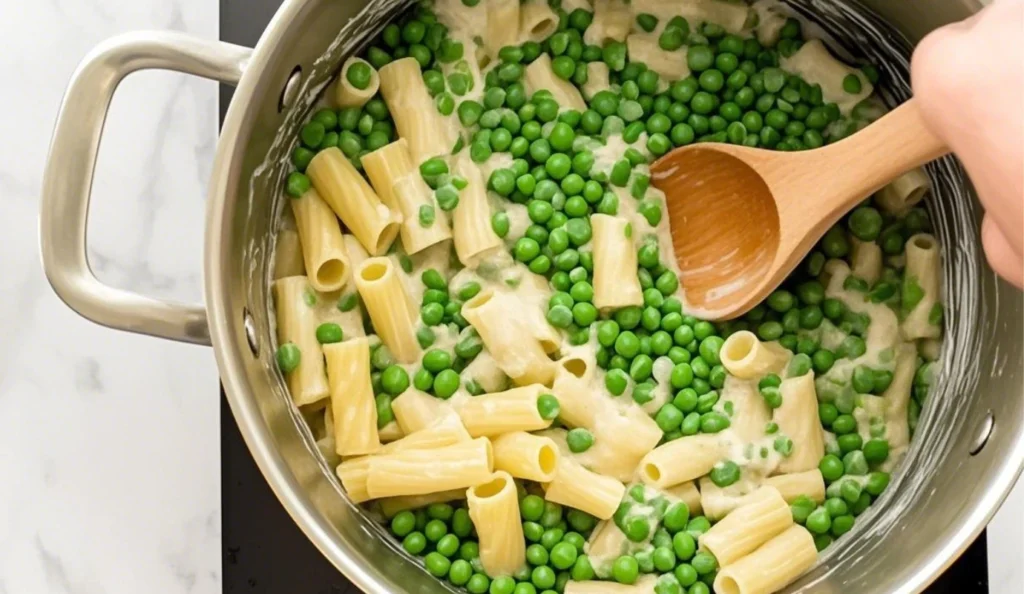
Expert Tips for the Best Creamy Pasta with Salmon and Peas
Selecting the Perfect Salmon
The salmon stands as the star ingredient in this dish, so choosing the right fillet makes a noticeable difference in your final result.
- Opt for center-cut salmon fillets when possible, as they cook more evenly
- Wild-caught salmon typically offers more flavor and nutrients than farm-raised varieties
- Look for flesh that appears moist and shiny with a deep pink or orange hue
- Fresh salmon shouldn’t have a strong fishy smell – just a clean, oceanic aroma
- If using frozen salmon, thaw it completely in the refrigerator overnight for best texture
- In a pinch, smoked salmon makes an excellent substitute – just fold it in at the very end since it’s already cooked
- For budget-conscious cooks, canned salmon works surprisingly well – drain thoroughly and gently fold in during the final minutes
Remember that salmon continues cooking even after removing from heat, so it’s better to err on the side of undercooking rather than overcooking. Perfect salmon should flake easily but remain moist and tender.
Pasta Perfection
The pasta provides the foundation for this dish, and several small techniques can elevate it from good to exceptional.
- Salt your pasta water generously – it should taste like seawater
- Stir pasta immediately after adding to water to prevent sticking
- Cook pasta just until al dente (with a slight firmness when bitten) as it will continue cooking briefly in the hot sauce
- Reserve pasta water before draining – this starchy liquid is liquid gold for creating silky sauces
- Don’t rinse pasta after draining – the starches on the surface help the sauce adhere
- Transfer pasta directly from colander to sauce rather than letting it sit and stick together
- Different pasta shapes create different experiences – try fettuccine for twirling, penne for catching sauce in its tubes, or orecchiette for cupping the peas
The right pasta, cooked properly, creates the perfect vehicle for delivering the creamy sauce and tender salmon to your palate.
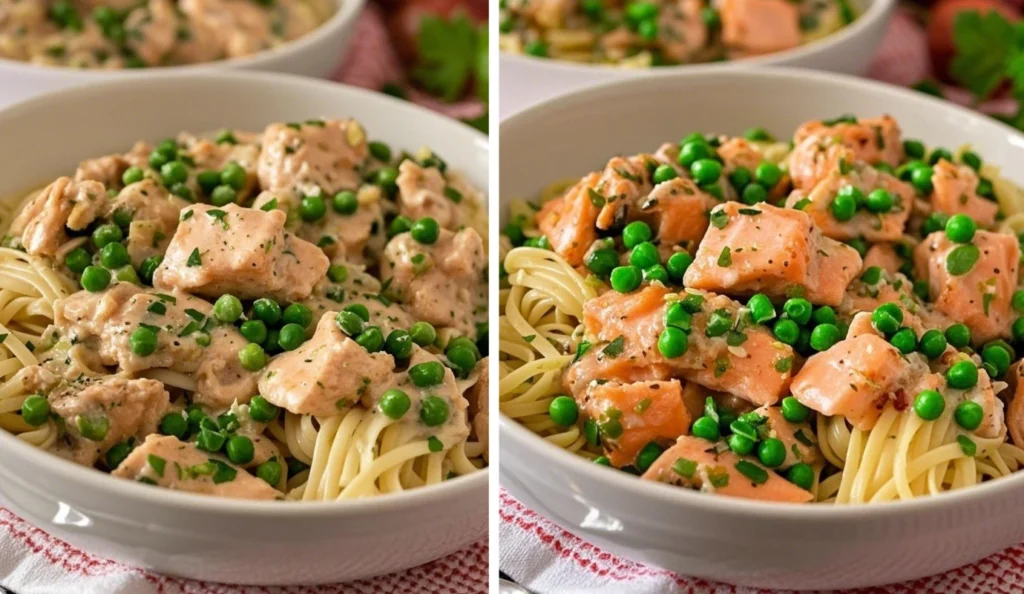
Making the Creamiest Sauce
The velvety sauce brings everything together, coating each strand of pasta and enhancing the flavor of the salmon and peas.
- Allow cream to come to room temperature before adding to prevent curdling
- Keep heat modest – a gentle simmer rather than a rolling boil preserves the cream’s texture
- Add cheese gradually and off the heat to prevent graininess
- If sauce becomes too thick, add reserved pasta water a tablespoon at a time until reaching desired consistency
- For extra richness, swirl in a tablespoon of cold butter just before serving
- Balance the richness with enough acid from the lemon to brighten the flavors
- Don’t skip the Parmesan – it adds both flavor and helps thicken the sauce
A perfectly executed cream sauce should coat the back of a spoon while still flowing freely – thick enough to cling to the pasta but not so thick it feels heavy.
Variations on Classic Pasta with Salmon and Peas
Lighter Version
For those seeking the same flavors with fewer calories, these modifications create a lighter yet still satisfying dish.
- Replace half the cream with chicken or vegetable broth
- Use half-and-half or whole milk instead of heavy cream (add 1 teaspoon of cornstarch mixed with cold milk to help thicken)
- Increase the vegetable content by adding asparagus tips, spinach, or halved cherry tomatoes
- Reduce the amount of Parmesan cheese and compensate with extra herbs and lemon zest
- Use more pasta water and less cream while still achieving a silky sauce
- Try whole wheat or protein-enriched pasta for additional nutritional benefits
These adjustments maintain the essence of the dish while creating a more everyday-appropriate option for health-conscious diners.
Dairy-Free Option
Those avoiding dairy can still enjoy this dish with these thoughtful substitutions.
- Replace heavy cream with full-fat coconut milk or cashew cream
- Skip the Parmesan or substitute with nutritional yeast for a cheesy flavor
- Add extra lemon juice and zest to compensate for the missing dairy tang
- Incorporate dijon mustard (1 teaspoon) for complexity
- Use dairy-free butter for added richness
- Add a splash of white wine to enhance flavor depth
- Finish with a drizzle of good olive oil for richness
With these modifications, dairy-free diners can experience the luxury of this dish without compromising their dietary needs.
Flavor Boosters
For those looking to expand the flavor profile of this already delicious dish, consider these enhancements.
- Deglaze the pan with 1/4 cup of dry white wine before adding the cream
- Add 1-2 tablespoons of capers for briny brightness
- Swap dill for other herbs like tarragon, basil, or chives
- Include 2 anchovy fillets when sautéing the shallots (they’ll dissolve and add depth without fishiness)
- Finish with a sprinkle of toasted pine nuts or breadcrumbs for textural contrast
- Add roasted red peppers for sweet, smoky notes
- Incorporate a teaspoon of Dijon mustard into the sauce for complexity
These additions create new dimensions within the dish without changing its fundamental character.
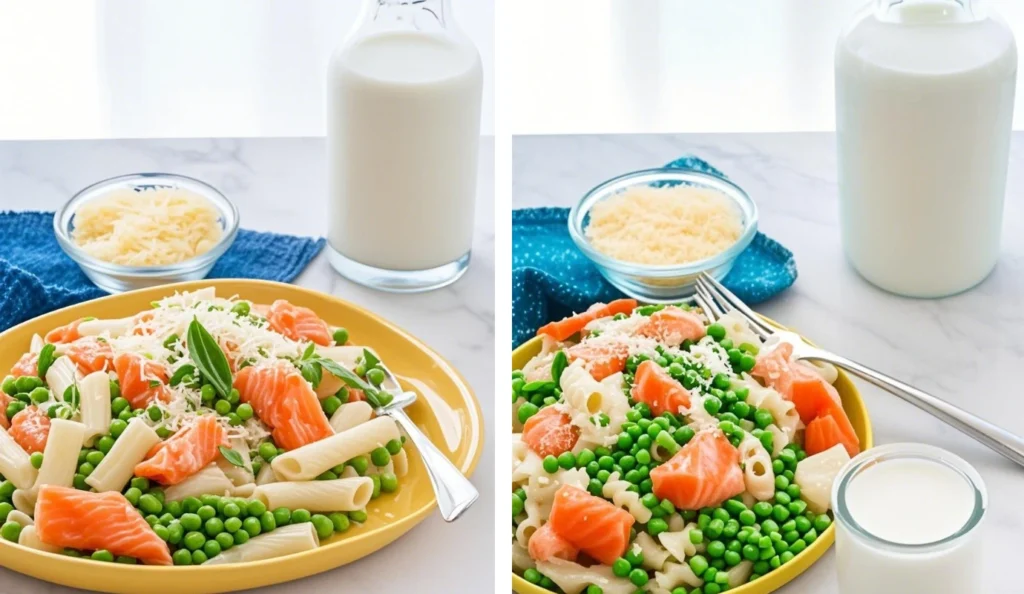
What to Serve with Your Pasta with Salmon and Peas
Side Dish Suggestions
While this pasta with salmon and peas stands perfectly well on its own as a complete meal, complementary side dishes can round out the dining experience.
- Simple green salad dressed with lemon vinaigrette cuts through the richness of the cream
- Garlic bread or crusty Italian bread provides textural contrast and helps soak up extra sauce
- Roasted asparagus or broccolini adds more vegetables and pairs beautifully with the salmon
- Sautéed cherry tomatoes offer acidic brightness that balances the creamy sauce
- Glass of crisp white wine such as Pinot Grigio, Sauvignon Blanc, or unoaked Chardonnay completes the meal
When selecting side dishes, aim for lighter options that contrast with rather than mirror the richness of the pasta. This creates a balanced meal that satisfies without overwhelming.
Make-Ahead and Storage Tips for Pasta with Salmon and Peas
Prep Components Ahead
While this dish comes together quickly, you can streamline the process even further with advance preparation.
- Cube salmon and store covered in refrigerator up to 24 hours (place on paper towels to absorb moisture)
- Chop shallots, mince garlic, and zest lemon up to 2 days ahead (store in separate airtight containers)
- Measure out dry ingredients and store together in a small bowl
- Grate cheese and store in refrigerator up to 5 days
- Wash and chop herbs the morning of (not earlier, as they’ll lose freshness)
Having these components ready allows you to assemble the dish in under 20 minutes when you’re ready to cook.
Storage Instructions
While best enjoyed fresh, leftovers can be managed with proper techniques.
- Refrigerate leftovers in an airtight container for up to 2 days
- Reheat gently on stovetop over medium-low heat with a splash of cream or milk to revive the sauce
- Add fresh herbs and a sprinkle of Parmesan after reheating to brighten flavors
- Avoid microwaving if possible, as it may cause the salmon to become tough
- This dish is not recommended for freezing, as the cream sauce will separate and the pasta texture will suffer
Properly stored and reheated, next-day leftovers make for a luxurious lunch that will have coworkers eyeing your meal with envy.
Nutritional Information for Creamy Pasta with Salmon and Peas
Understanding the nutritional profile helps fit this dish into your overall meal planning. While indulgent, it also provides substantial nutritional benefits, particularly from the salmon.
| Nutrient | Amount per Serving |
|---|---|
| Calories | 680 |
| Protein | 35g |
| Carbohydrates | 56g |
| Fat | 37g |
| Fiber | 4g |
| Sodium | 320mg |
| Calcium | 15% DV |
| Iron | 12% DV |
| Omega-3 fatty acids | 2.2g |
| Vitamin D | 45% DV |
| Vitamin B12 | 80% DV |
Based on 4 servings. Values are approximate and may vary based on specific ingredients used.
The impressive nutritional profile showcases how this dish delivers more than just flavor. The substantial protein content supports muscle maintenance, while the omega-3 fatty acids from salmon provide heart and brain health benefits. The calcium from dairy ingredients supports bone health, and the carbohydrates offer energy. Even with its rich taste, this pasta with salmon and peas contributes significantly to your daily nutritional needs.
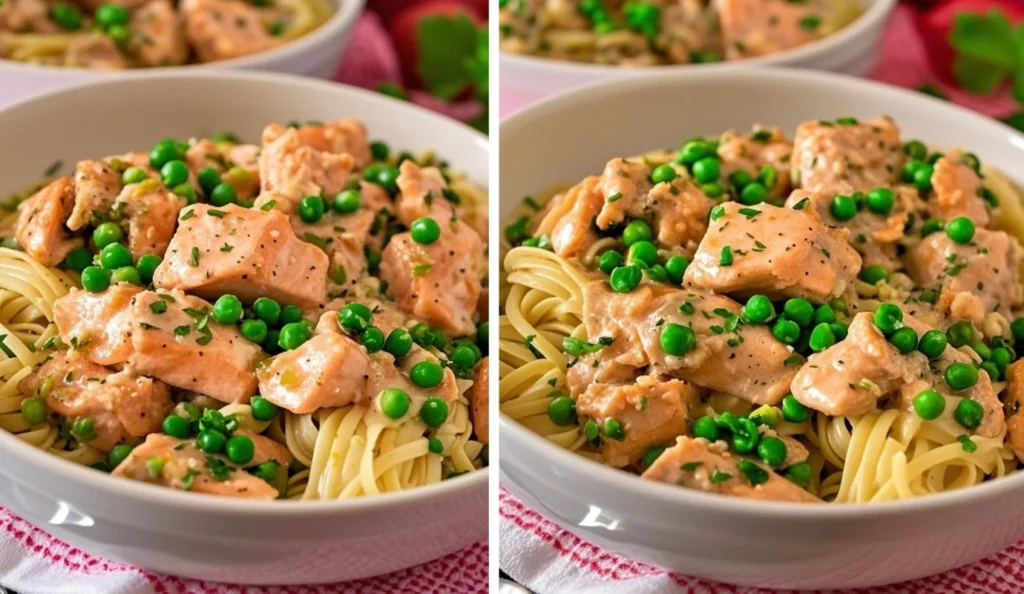
Conclusion: A Weeknight Recipe That Feels Special
In the realm of home cooking, few dishes manage to bridge the gap between everyday accessibility and special-occasion worthiness quite like this creamy pasta with salmon and peas. It’s a reminder that extraordinary meals don’t require extraordinary effort – just thoughtful ingredient combinations and simple techniques applied with care.
This recipe deserves a spot in your culinary repertoire because it solves the common dilemma of wanting something delicious without spending hours in the kitchen. When time feels scarce but you refuse to compromise on flavor, this dish delivers satisfaction on multiple levels.
The next time you find yourself staring blankly into the refrigerator at 6 PM, remember that a restaurant-worthy meal is just 30 minutes away. With minimal ingredients and equipment, you can create something that nourishes both body and spirit – a dish that transforms an ordinary evening into something memorable.
Give this creamy pasta with salmon and peas a try this week. Your taste buds will thank you, your dinner companions will be impressed, and you’ll discover a new favorite that bridges the gap between everyday cooking and special occasion dining. Share your results on social media or in the comments below – we’d love to see how your version turns out and hear about any personal touches you added to make it your own!
FAQ About Pasta with Salmon and Peas
Can I use canned salmon for pasta with salmon and peas?
Yes, you can absolutely substitute canned salmon in this creamy pasta with salmon and peas recipe, making it both economical and pantry-friendly. Opt for boneless, skinless varieties for convenience, though traditional canned salmon works too with a bit more preparation. Simply drain thoroughly, remove any bones if present, and gently fold into the cream sauce during the final few minutes of cooking. Since canned salmon is already cooked, it merely needs heating through rather than cooking from raw. While fresh salmon provides optimal texture and a more delicate flavor profile, canned salmon delivers comparable nutritional benefits with added convenience and significantly reduced cost, making this luxurious dish accessible for everyday meals.
What’s the best pasta shape to use with salmon and peas?
The ideal pasta shapes for creamy pasta with salmon and peas combine form with function – they should capture the sauce while creating pockets for the smaller ingredients. Long, flat noodles like fettuccine or linguine excel at gathering the silky sauce with each twirl. Medium shapes such as penne, fusilli, or farfalle effectively trap peas and salmon chunks within their crevices. Smaller shapes like orecchiette literally create little “ears” that cradle the peas perfectly. Consider your dining scenario when choosing – long pastas create elegant presentation for dinner parties, while shorter shapes offer easier eating for family meals. The pasta’s thickness should complement the substantial nature of the sauce – overly delicate varieties might collapse under the creamy weight.
Can I make pasta with salmon and peas ahead of time?
While creamy pasta with salmon and peas reaches its pinnacle when freshly prepared, strategic advance preparation can streamline your cooking process without sacrificing quality. For best results, consider component preparation rather than full assembly: cook pasta until slightly underdone, toss with a touch of olive oil, and refrigerate; prepare the cream sauce without adding salmon or peas, then refrigerate separately; cube salmon and store wrapped in paper towels to absorb moisture. When ready to serve, gently reheat the sauce, add salmon and peas to cook through, then fold in the pasta with a splash of fresh cream to revitalize the consistency. Complete make-ahead assembly isn’t recommended as the sauce tends to separate upon reheating and pasta continues absorbing liquid, potentially becoming mushy.
Is pasta with salmon and peas healthy?
Creamy pasta with salmon and peas strikes a remarkable balance between indulgence and nutrition. While cream-based pastas aren’t typically categorized as “diet food,” this particular combination delivers substantial nutritional benefits. Salmon provides high-quality protein, essential omega-3 fatty acids that support heart and brain health, and vitamin D – nutrients many modern diets lack. Peas contribute plant-based protein, fiber, and vitamins A and K. The dish’s nutritional profile can be enhanced by choosing whole grain pasta for additional fiber and using measured portions of cream and cheese. Rather than viewing it through a strict “healthy/unhealthy” binary, consider this dish as nutritionally complex – offering genuine health benefits alongside its more indulgent elements. For those monitoring specific dietary concerns, the lighter variations detailed above maintain the dish’s essence while reducing calories and fat.
What can I substitute for cream in pasta with salmon and peas?
Creating a delicious pasta with salmon and peas without heavy cream is entirely possible with several clever substitutions that maintain the dish’s signature silkiness. For a lighter dairy option, combine whole milk or half-and-half with a teaspoon of cornstarch or flour to achieve thickness without excessive richness. Greek yogurt thinned with a bit of milk delivers comparable creaminess plus a pleasant tangy note that complements the salmon beautifully. For dairy-free adaptations, full-fat coconut milk creates luxurious texture with a subtle sweetness that pairs surprisingly well with seafood, while cashew cream offers neutral creaminess that lets the salmon shine. Perhaps most surprising is the technique of creating a creamy emulsion from the pasta cooking water and olive oil, enhanced with additional Parmesan – allowing the starchy water to create body without any cream at all.

